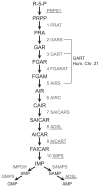Mutations in the Chinese hamster ovary cell GART gene of de novo purine synthesis
- PMID: 19007868
- PMCID: PMC2643067
- DOI: 10.1016/j.gene.2008.10.007
Mutations in the Chinese hamster ovary cell GART gene of de novo purine synthesis
Abstract
Mutations in several steps of de novo purine synthesis lead to human inborn errors of metabolism often characterized by mental retardation, hypotonia, sensorineural hearing loss, optic atrophy, and other features. In animals, the phosphoribosylglycinamide transformylase (GART) gene encodes a trifunctional protein carrying out 3 steps of de novo purine synthesis, phosphoribosylglycinamide synthase (GARS), phosphoribosylglycinamide transformylase (also abbreviated as GART), and phosphoribosylaminoimidazole synthetase (AIRS) and a smaller protein that contains only the GARS domain of GART as a functional protein. The GART gene is located on human chromosome 21 and is aberrantly regulated and overexpressed in individuals with Down syndrome (DS), and may be involved in the phenotype of DS. The GART activity of GART requires 10-formyltetrahydrofolate and has been a target for anti-cancer drugs. Thus, a considerable amount of information is available about GART, while less is known about the GARS and AIRS domains. Here we demonstrate that the amino acid residue glu75 is essential for the activity of the GARS enzyme and that the gly684 residue is essential for the activity of the AIRS enzyme by analysis of mutations in the Chinese hamster ovary (CHO-K1) cell that require purines for growth. We report the effects of these mutations on mRNA and protein content for GART and GARS. Further, we discuss the likely mechanisms by which mutations inactivating the GART protein might arise in CHO-K1 cells.
Figures




Similar articles
-
Phylogenetic analysis and in silico characterization of the GARS-AIRS-GART gene which codes for a tri-functional enzyme protein involved in de novo purine biosynthesis.Mol Biotechnol. 2009 Jul;42(3):306-19. doi: 10.1007/s12033-009-9160-1. Epub 2009 Mar 20. Mol Biotechnol. 2009. PMID: 19301155
-
The human GARS-AIRS-GART gene encodes two proteins which are differentially expressed during human brain development and temporally overexpressed in cerebellum of individuals with Down syndrome.Hum Mol Genet. 1997 Nov;6(12):2043-50. doi: 10.1093/hmg/6.12.2043. Hum Mol Genet. 1997. PMID: 9328467
-
Zebrafish mutations in gart and paics identify crucial roles for de novo purine synthesis in vertebrate pigmentation and ocular development.Development. 2009 Aug;136(15):2601-11. doi: 10.1242/dev.038315. Epub 2009 Jul 1. Development. 2009. PMID: 19570845 Free PMC article.
-
Potential interaction between the GARS-AIRS-GART Gene and CP2/LBP-1c/LSF transcription factor in Down syndrome-related Alzheimer disease.Cell Mol Neurobiol. 2007 Dec;27(8):1117-26. doi: 10.1007/s10571-007-9217-2. Epub 2007 Sep 28. Cell Mol Neurobiol. 2007. PMID: 17902044 Free PMC article.
-
Expression of a human cDNA encoding a protein containing GAR synthetase, AIR synthetase, and GAR transformylase corrects the defects in mutant Chinese hamster ovary cells lacking these activities.Somat Cell Mol Genet. 1991 Jul;17(4):411-20. doi: 10.1007/BF01233066. Somat Cell Mol Genet. 1991. PMID: 1887337
Cited by
-
Identification of miRNAs and genes for predicting Barrett's esophagus progressing to esophageal adenocarcinoma using miRNA-mRNA integrated analysis.PLoS One. 2021 Nov 24;16(11):e0260353. doi: 10.1371/journal.pone.0260353. eCollection 2021. PLoS One. 2021. PMID: 34818353 Free PMC article.
-
Molecular genetic analysis of Down syndrome.Hum Genet. 2009 Jul;126(1):195-214. doi: 10.1007/s00439-009-0696-8. Epub 2009 Jun 13. Hum Genet. 2009. PMID: 19526251 Review.
-
Identification of Potential Biomarkers for Patients with DWI-Negative Ischemic Stroke.J Mol Neurosci. 2024 Jul 12;74(3):68. doi: 10.1007/s12031-024-02229-z. J Mol Neurosci. 2024. PMID: 38995420 Free PMC article.
-
Phylogenetic analysis and in silico characterization of the GARS-AIRS-GART gene which codes for a tri-functional enzyme protein involved in de novo purine biosynthesis.Mol Biotechnol. 2009 Jul;42(3):306-19. doi: 10.1007/s12033-009-9160-1. Epub 2009 Mar 20. Mol Biotechnol. 2009. PMID: 19301155
-
Oxidative Stress and Down Syndrome: A Route toward Alzheimer-Like Dementia.Curr Gerontol Geriatr Res. 2012;2012:724904. doi: 10.1155/2012/724904. Epub 2011 Nov 29. Curr Gerontol Geriatr Res. 2012. PMID: 22203843 Free PMC article.
References
-
- Aimi J, Qiu H, Williams J, Dixon JE. De novo purine nucleotide biosynthesis: cloning of human and avian cDNAs encoding the trifunctional glycinamide ribonucleotide synthetase-aminoimidazole ribonucleotide synthetase-glycinamide ribonucleotide transformylase by functional complementation in E. coli. Nuc Acid Res. 1990;18:6665–6672. - PMC - PubMed
-
- An S, Kumar R, Sheets ED, Benkovic SJ. Reversible compartmentalization of de novo purine biosynthetic complexes in living cells. Science. 2008;320:103–6. - PubMed
-
- Ausubel FM. Current Protocols in Molecular Biology. J Wiley; Brooklyn, NY: 1987.
-
- Barnes TS, Bleskan JH, Hart IM, Walton KM, Barton JW, Patterson D. Purification of, generation of monoclonal antibodies to, and mapping of phosphoribosyl N-formylglycinamide amidotransferase. Biochemistry. 1994;33:1850–1860. - PubMed
-
- Becker MA, Nosal JM, Switzer RL, Smith PR, Palella TD, Roessler BJ. Point mutations in PRPS1, the gene encoding the PRPP synthetase (PRS) 1 isoform, underlie X-linked PRS superactivity associated with purine nucleotide inhibitor-resistance. Adv Exp Med Biol. 1994;370:707–710. - PubMed
Publication types
MeSH terms
Substances
Associated data
- Actions
Grants and funding
LinkOut - more resources
Full Text Sources

